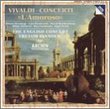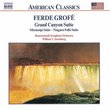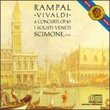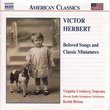| All Artists: David [6] Diamond, Gerard Schwarz, Seattle Symphony Orchestra Title: David Diamond: Symphonies Nos. 2 & 4 Members Wishing: 0 Total Copies: 0 Label: Naxos American Release Date: 6/15/2004 Genre: Classical Styles: Historical Periods, Modern, 20th, & 21st Century, Symphonies Number of Discs: 1 SwapaCD Credits: 1 UPC: 636943915424 |
Search - David [6] Diamond, Gerard Schwarz, Seattle Symphony Orchestra :: David Diamond: Symphonies Nos. 2 & 4
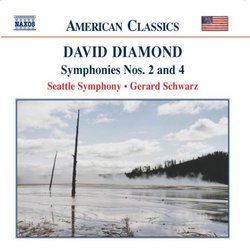 | David [6] Diamond, Gerard Schwarz, Seattle Symphony Orchestra David Diamond: Symphonies Nos. 2 & 4 Genre: Classical
"To me, the romantic spirit in music is important because it is timeless." These words by David Diamond capture the essence not only of the composer himself, but of an entire generation of American composers whose heartfel... more » |
Larger Image |
CD DetailsSynopsis
Album Description "To me, the romantic spirit in music is important because it is timeless." These words by David Diamond capture the essence not only of the composer himself, but of an entire generation of American composers whose heartfelt music was born during the Great Depression and World War II. Symphony No. 2 begins with an elegiac slow movement whose textures recall the "American" sound of Copland as well as the lean beauty of the Adagio finale of Mahler?s Ninth Symphony, countered by the optimism of the concluding rondo, based on a jaunty, unmistakably "American" theme. Symphony No. 4, dating from the final year of World War II, is a compact, probing work created at a time when Diamond was preoccupied with thoughts of mortality. It concludes, nevertheless, wth an assertive and exuberant finale which breathes the fresh air of the American outdoors. Similarly Requested CDs
|
CD ReviewsValuable Reissue from the Schwarz/Seattle Diamond Series J Scott Morrison | Middlebury VT, USA | 06/26/2004 (5 out of 5 stars) ""It is my strong feeling that a romantically inspired contemporary music, tempered by reinvigorated classical technical formulas is the way out of the present period of creative chaos in music...To me, the romantic spirit in music is important because it is timeless." -- David DiamondAmen to that. This CD is a partial reissue of a Delos CD which came out in 1990 at the time of David Diamond's 75th birthday. The Delos also contained the 13-minute 'Concerto for Small Orchestra,' which I presume will be coupled with something else in this ongoing Naxos reissue of the whole series of Diamond recordings made by Gerard Schwarz and the Seattle Symphony from that time. Symphony No. 2 reminds me of the comment Schoenberg made to Diamond when the latter asked about the possibility of study with him. Schoenberg said, 'Why do you need to? You're the new Bruckner...I never meant [the twelve-tone technique] for everybody." This symphony is surely Diamond's most Brucknerian, not so much in its sound as in its unhurried long-spanned structure. Indeed, I've always thought of this four-movement 43-minute work as really consisting of two long Brucknerian movements arranged so: 1 2 | 3 4, where 1 & 3 are elegiac and lyrical adagios leading directly to 2 & 4, which are vigorous allegros. Further, material from 1 reappears in 3, as material from 2 recurs in 4. The slow movements are threnodies; the symphony was written in 1942-43, during America's early days in the uncertainties of World War II. They contain much soft, slow-moving mostly string music with treading soft timpani, melancholy Coplandesque solo woodwind melodies and low brass interjections; the overall effect is that of hieratic elegies that occasionally rise to anguished or triumphant climaxes. The two fast movements share material that is distinctly American sounding and they display Diamond's expert manipulation of harmony (e.g., 'walking tenths' creatively re-harmonized) and energetic and inventive rhythms, the latter spiked by chordal brass interjections that surely were inspired by big band arrangements of the time. My only quibble with the Second Symphony is that is overstays its welcome somewhat, particularly in the second movement, which could have conveyed its optimistic message more concisely. The fourth movement, however, does that refreshingly. If you know the finale of Randall Thompson's Second Symphony you'll have some idea of the spirit of this fourth movement.The 16-minute, three-movement Fourth Symphony, possibly Diamond's most-played, was written at the end of the War and premièred by the young Leonard Bernstein, substituting for an ailing Koussevitzky. The three movements, Diamond tells us, are based on G.T. Fechner's notions of life and death: I - a continual sleep; II - the alternation between sleeping and waking; III - eternal waking, Birth being the passing from I to II and Death from II to III. (I am indebted to the booklet notes newly written by Steven Lowe for this Naxos reissue.) Be that as it may, the Second is an immediately emotionally engaging work that, if one doesn't know the 'program,' can be heard primarily as a superbly crafted, harmonically exciting, melodically attractive work whose movements are Allegretto - Adagio - Allegro. Diamond's admiration for the clarity of Ravel (and his early study with Nadia Boulanger) is apparent here. The form is crytal clear notwithstanding the soft edges of the music itself. One hears echoes of the blurry impressionistic orchestrations of Martinu, say, coupled with pastoral and chorale-like melodies. The third movement, with its jazzy brass and asymmetric 'urban' rhythms could not have been written by anyone other than an American, and they leave one invigorated.These performances are not likely to be bettered any time soon. The lifelike sound on this release is virtually indistinguishable from that on the original Delos release which can still be found for purchase, but Naxos's budget price trumps the Delos alternative. Recommended.TT=59:19Scott Morrison" Nice to have, for two tracks Jeff Dunn | Alameda, California United States | 06/18/2005 (3 out of 5 stars) "Gerard Schwarz, the conductor and strong Diamond advocate, calls the Second "arguably the greatest American symphony." As a Believer, Schwarz makes the strongest possible case, performance-wise, for these works. I was impressed with the first two movements of the Second Symphony, but the rest sounded like too much 40's-style notespinning. If you're looking for the Great American Symphony, try the Barber First, the Schuman Third, the Harris Third, the Shapero, or best of all but hard to find, Sebastian Currier's "Microsymph." If you're looking for good music of the period, subperbly performed, this recording can't be beat, and the price is right." An American treasure Virginia Lewis | 09/01/2007 (5 out of 5 stars) "Proof positive that David Diamond is indeed an American treasure. When I was growing up with my classical music loving father, I heard primarily about Gerschwin and Copland, those were the composers everyone talked about if they talked about such music at all. I never heard about Piston or Diamond or Harris or Gould. As someone who admires Aaron Copland profoundly, I must rank David Diamond's symphonic music on a direct par with Copland's. His sense of symmetry and organization is deeply satisfying, and his moving harmonic lines and dramatic bursts of brass and percussion create an emotional experience that ranks among the most rewarding in all symphonic music. His orchestration is replete with variety and mastery. If there is anything at all that jars in his music, it is the occasional apologetic ending of certain movements. But this is a sort of signature of Diamond's, a method of driving the listener to return in her mind to what she has just heard and review it, turn it over in her head. Doing so is irresistible, as the musical experience Diamond creates with his symphonies is among the most meaningful I've ever enjoyed. An ideal listening experience, even in this inexpensive Naxos recording. An incredible bargain."
|

 Track Listings (7) - Disc #1
Track Listings (7) - Disc #1
